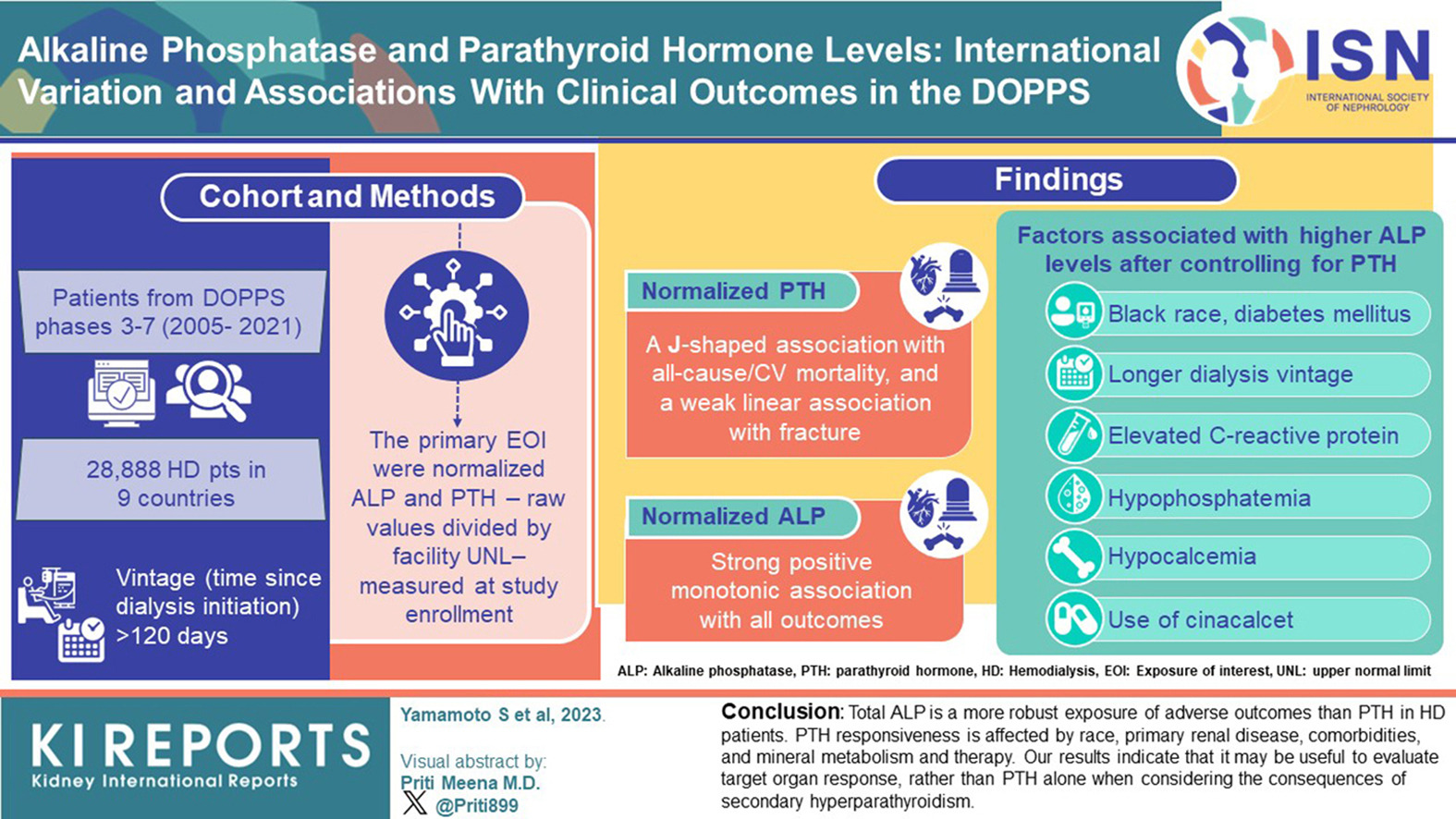Share
Share

The Dialysis Outcomes and Practice Patterns Study (DOPPS) Program at Arbor Research Collaborative for Health is pleased to share their recent publication recognized as one of the most- downloaded articles at Kidney International Reports in the past few weeks titled “Alkaline Phosphatase and Parathyroid Hormone Levels: International Variation and Associations With Clinical Outcomes in the DOPPS”. The study sheds light on the critical role of total alkaline phosphatase as a more robust indicator of adverse outcomes than parathyroid hormone in patients undergoing hemodialysis. This paper is accessible in KI Reports (read the paper here). Following are key findings regarding this study.
Key findings from this manuscript include:
28,888 Patients receiving hemodialysis (HD) in nine countries in the Dialysis Outcomes and Practice Patterns Study (DOPPS) were included in this analysis. Primary exposures of interest were normalized alkaline phosphatase (ALP) and parathyroid hormone (PTH). Cox models were used to estimate hazard ratios of all-cause or cardiovascular mortality and any or hip fracture adjusted for potential confounders. Linear mixed models were constructed to investigate the relationship between normalized ALP levels and patient characteristics.
Normalized PTH had a J-shaped association with all-cause or cardiovascular mortality, and a weak linear association with fracture. In contrast, there was a strong association with all outcomes for normalized ALP. After controlling for PTH, Black race, longer dialysis vintage, diabetes mellitus, hypocalcemia, hypophosphatemia, elevated C-reactive protein, and the use of cinacalcet were all associated with higher ALP levels.
-
Evaluating target organ response is more useful, rather than relying solely on PTH levels when considering the consequences of secondary hyperparathyroidism (SHPT). PTH responsiveness is affected by race, primary renal disease, comorbidities, and mineral metabolism and therapy. Emphasizing the importance of total ALP as a comprehensive marker may offer a more nuanced and personalized approach to managing patients receiving HD.
Understanding the variations in PTH responsiveness and recognizing the impact of Total ALP on clinical outcomes can have profound implications for patient care. This research paves the way for a more tailored and effective management strategy for individuals undergoing hemodialysis, offering health care professionals valuable insights into optimizing treatment plans.
About the DOPPS Program: Our goals are to improve the experience of patients with kidney disease by understanding current clinical practice, identifying practices associated with best outcomes, and serving as a resource for the kidney community. Started as a hemodialysis study in 1996, the DOPPS Program has followed over 200,000 persons receiving dialysis for end-stage kidney failure at more than 750 clinical sites in >20 countries. We focus on the lives of individuals with advanced non- dialysis chronic kidney disease (CKDopps) or with kidney failure treated by in-center hemodialysis (DOPPS) or peritoneal dialysis (PDOPPS).
The DOPPS Program is funded by a consortium of private industry, professional societies, and public funding sources. Please visit DOPPS.org to learn more about the DOPPS Program, our support, and opportunities for collaboration.
Arbor Research Collaborative for Health is proud of its role as the Data Coordinating Center for the Worldwide Integration of Natural History Databases for Primary Sclerosing Cholangitis (WIND-PSC) study, a groundbreaking research initiative led by PSC Partners and PSC Partners Canada. These patient-led non-profit organizations are dedicated to supporting education and research in primary sclerosing […]
The latest episode of the Global Kidney Care Podcast, a collaborative effort by the International Society of Nephrology (ISN), the International Society for Peritoneal Dialysis (ISPD), and Arbor Research Collaborative for Health, was released on June 3, 2024. This special episode focuses on Arbor Research’s Peritoneal Dialysis Outcomes and Practice Patterns Study (PDOPPS), a groundbreaking […]
Ann Arbor, MI — The American Heart Association has released a new scientific statement titled “Implementation of Obesity Science Into Clinical Practice: A Scientific Statement From the American Heart Association,” in its flagship scientific journal Circulation. This statement underscores the pressing need to bridge the gap between obesity research and real-world application in clinical settings. […]
Arbor Research Collaborative for Health (Arbor Research), a leading provider of innovative solutions in healthcare research, is pleased to announce its participation in the upcoming World Congress of Nephrology (WCN) 2024, scheduled to take place from April 13th to 16th, 2024. The WCN 2024 conference, organized by the International Society of Nephrology (ISN), is a […]